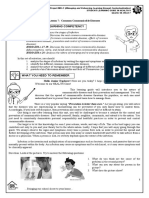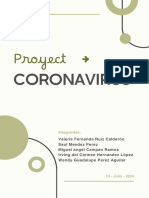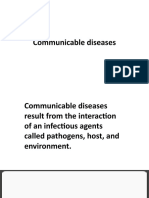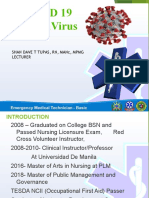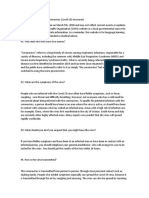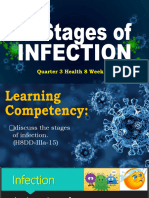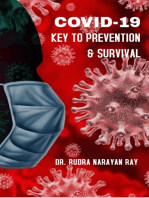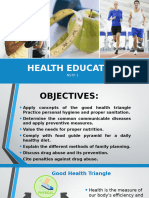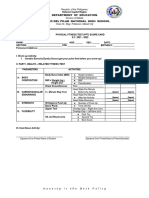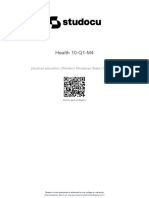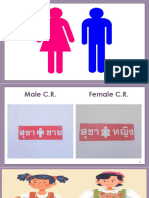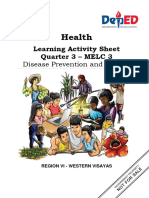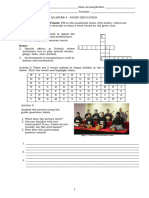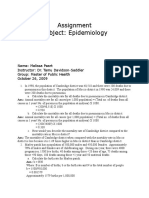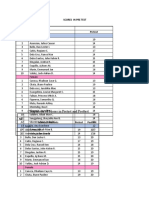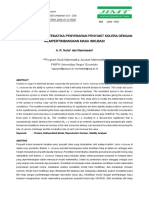HG 8 3rd Quarter
HG 8 3rd Quarter
Uploaded by
Albert Ian CasugaCopyright:
Available Formats
HG 8 3rd Quarter
HG 8 3rd Quarter
Uploaded by
Albert Ian CasugaCopyright
Available Formats
Share this document
Did you find this document useful?
Is this content inappropriate?
Copyright:
Available Formats
HG 8 3rd Quarter
HG 8 3rd Quarter
Uploaded by
Albert Ian CasugaCopyright:
Available Formats
lOMoARcPSD|34930482
I. What I Need to Know?
At the end of this Learning Activity Sheet, you are expected to:
discussed the stages of infection; (H8DD-IIIa-15 / Week 1)
analyzed the leading causes of morbidity and mortality in the Philippines;
and (H8DD-IIIa-16 /Week 1)
discussed the most common communicable diseases; its sign and
symptoms,effects,misconceptions,myths, beliefs and prevention and control
of common communicable diseases.(H8DD-IIIb-c-17) (H8DD-IIIb-c-18)
(H8DD-IIIb-c-19/ Weeks 2-3)
II. What I Know?
Activity 1: True or False
Directions: Read each statement about the nature of communicable diseases. You
will be guided in determining whether the statement is true or false by putting a check
(/) mark n the appropriate column.Write your answer on a separate sheets of paper.
Statement True False
1 Incubation period varies from hours to months,depending on the
type of pathogen.
2 Acute stage is the period when more specific signs and
symptoms appear.
3 Accidents is one of the leading causes of morbidity rate in our
country.
4 One of the leading causes of mortality rate in the Philippines is
the disease of the heart.
5 Communicable diseases come from one infected person to
another.
6 Stomache is one symptom that can be manifested by a
communicable disease.
7 Handshake with a sick person could get you ill too.
8 People in the province usually get ill because of disturbed spirits.
9 Frequent handwashing,wearing face masks and face shields
could help you avoid catch droplet transmission.
10 Seek medical advice immediately when not feeling well.
Downloaded by Albert Ian Casuga (teacher.albert2020@gmail.com)
lOMoARcPSD|34930482
Lesson
1 Keep Me Posted
Communicable diseases or infectious disease is any illnesses that can be
passed from one person to another, that is caused by direct or indirect spread of
pathogens.Infectious diseases like the emerging Covid-19 disease had claimed lives
and affected our population. This disease had been stemming the tide of its
transmission.Our government and medical experts never stop looking ways and
finding cures and solutions to this epidemic.
Pandemic brought a lot of problems in the whole world, signs and
symptoms of Covid-19 can be considered as one of the leading causes of morbidity
and mortality in the Philippines. Morbidity is infectious in nature in which the elderly
people and other vulnerable suffers both degenerative and communicable diseases
due to the ageing of the body’s immune system. That’s the reason why older people
who were at aged 60 and above and younger ones were are not allowed to go outside
during pandemic.
III. What’s In?
Activity 2: Complete the Conversation
Directions: Read the questions inside the dialogue box. Write your answers in a
separate sheets of paper.
Have you ever been sick? ____________________
_____________________
Why do you get sick?
_
What do you do when you ____________________
get sick?
How will you prevent being
___________________
sick?
https://www.vecteezy.com/vector-art/299055-young-boy-and-girl-talking
Downloaded by Albert Ian Casuga (teacher.albert2020@gmail.com)
lOMoARcPSD|34930482
IV. What’s New?
Activity 3: Word Hunt
Directions: Find the ten words associated with different diseases referring to leading
causes of morbidity and mortality. Write your answers on a separate sheets of paper.
D I A B E T E S T H
P N N R R C F C T Y
N F A O H O D O U P
P L D N I D E V B E
N U E C V S N I E R
E E N H D H G V R T
U N G I I E U E C E
M Z A T D A E A O N
O A E I S R F V L S
N A S S O I I D O I
I N J U H H E S S O
A C C I D E N T I N
N E P H R O S I S I
V.What is It?
Coronavirus is one of the many viruses that we have at this so called new normal. The
government needs to impose some protocols to follow. People need to wear masks and face
shields when going out and frequent washing of hands. This is to prevent the spread of the virus
and to be infected with the disease brought by coronavirus.
When a person acquires an infection. He /she must observe signs and symptoms of
infection and take appropriate actions to prevent the spread like staying away from other people,
and taking the doctor’s advice seriously. Infection follows a progressive course, the severity of
the sick person’s illness depends on the extent of the infection, the pathogenicity of the
microorganism and susceptibility of the host.
FIVE STAGES of INFECTION
1.INCUBATION STAGE
Is the time between the exposure to a contagious disease and the appearance of symptoms.
The incubation period varies from hours to months, depending on the type of pathogens.
Example: Cold can develop in a few hours,1 to 2 days incubation. Influenza takes 1 to 3 days
and chickenpox takes 2 to 3 weeks of incubation.
Downloaded by Albert Ian Casuga (teacher.albert2020@gmail.com)
lOMoARcPSD|34930482
2.PRODROMAL STAGE
Starts from the onset, generally last about one or two days, during which the body reacts to
the presence of pathogens. Signs and symptoms of the disease show during this stage. The
disease is now communicable at this stage.
3.ILLNESS /ACUTE STAGE
A period when the disease is at its highest point that the signs and symptoms can be
clinically tested to diagnose the disease.
4. DECLINING STAGE
The period when symptoms start to subside and the patient may feel improvement but still
cannot return to doing normal activities. The infection is still present but now reduced.
5.CONVALESCENT STAGE
Is when the patient recovers his/her strength and returns to his/her normal state of Health
The 21st century’s major health problem and development challenges is on the non-
communicable diseases.It was the leading cause of death globally that affects population in a
low and middle income countries.
Morbidity is the state of an individual, or the occurrence of illness in a population; while
Mortality is the number of deaths in a population.
According to the Department of Health, the leading causes of mortality and morbidity
in the Philippines for 2008-2012 and 2013 as follows:
TOP 10 LEADING CAUSES OF MORTALITY
https://doh.gov.ph/mortality
Downloaded by Albert Ian Casuga (teacher.albert2020@gmail.com)
lOMoARcPSD|34930482
TOP 10 LEADING CAUSES OF MORBIDITY
https://doh.gov.ph/morbidity
Communicable Diseases
Common communicable disease or infectious disease is any illness that you can “catch”
or can be passed from one person to another.
The table below will help you learn about the common communicable diseases.
Disease Infectious Agent Signs and Treatment or
Symptoms Management
Acute Adenoviruses Congestion either Rest well, increase
Respiratory in the nasal fluid intake;
Rhinoviruses
Infections sinuses or lungs,
Cough and cold
Pneumococcus runny nose,
-infection in the medications can be
cough, sore throat,
upper or lower taken to reduce
body aches,
respiratory tract symptoms.
fatigue
that prevents
normal breathing
Pneumonia Bacteria Chills, high fever, Treat with antibiotics;
dyspnea, pleuritic Hospitalization for
-infection of the
chest pain severe cases and
lungs wherein the
Viruses worsened by deep cases in infants.
air sac or alveoli
inspiration, cough,
are filled with pus
crackles and
and fluid which
Fungi wheezes heard on
limits oxygen
breath sounds
intake
Downloaded by Albert Ian Casuga (teacher.albert2020@gmail.com)
lOMoARcPSD|34930482
Bronchitis Viruses Persistent cough Take rest, drink fluids,
lasting for weeks, Breathe warm and
-inflammation of
wheezing, chest moist air,
the bronchial
Bacteria discomfort, low
tubes, the air Take medications for
fever and chills,
passages between cough and pains.
sore throat, body
the nose and the
Irritant particles aches, blocked Take antibiotics (for
lungs
nose and sinuses bacterial infection)
Influenza (flu) Flu virus (Type A, Sudden onset of Bed rest
B and C) high fever lasting
-a highly Take plenty of fluids
for three to five
contagious viral
days; headache, In severe cases,
infection affecting
muscle ache and antiviral medications
the respiratory
joint pains; dry are prescribed.
system
cough; chills;
fatigue; malaise
(not feeling well),
nasal congestion
Tubercolosis Bacteria Cough that is Standard six-month
(Mycobacterium worse in the course of four
-an infectious
tuberculosis) morning and lasts antibiotics
bacterial disease
three weeks or
that commonly
longer (sometimes
affects the lungs
with blood in the
sputum) chest
pain,
breathlessness,
night sweats, sign
of pneumonia,
weight loss,
weakness or
fatigue
Dengue Dengue virus (four Fever up to 41 Rest
strains) centigrade,
-is a mosquito- Drink plenty of fluids
headaches,
borne disease
muscle, bones, Pain medications can
mostly occurring in
joint paint, pain be taken except for
tropical and sub-
behind your eyes, those that may
tropical areas
widespread rash, increase bleeding
nausea and complications
vomiting minor
bleeding from your Hospitalization is
gums or nose needed in severe
cases.
Downloaded by Albert Ian Casuga (teacher.albert2020@gmail.com)
lOMoARcPSD|34930482
Sexually Bacteria Unusual discharge Antibacterial and
Transmitted from the penis, antiviral medications
Infections (STIs) vagina, anus :pain
Viruses during sex or
-infections that can
urination; sores,
be acquired
blister, ulcers,
predominantly
Fungi warts or rashes in
through
the genital area;
unprotected sexual
fever or flu-like
contact.
Protozoa symptoms;
Ex: chlamydia, abnormal or
unusual vagina
gonorrhea, syphilis bleeding; pain in
and herpes the scrotum or
testicles; lumps
and bumps on
genitals
HIV and AIDS Human Fever and night There is no treatment
Immunodeficiency sweat, feeling very but there are
-AIDS (Acquired
virus tired, quick weight medications that can
Immunodeficiency
loss, headache, slow down the
Syndrome) is a
progress of the
chronic, life- enlarged lymph
disease.
threatening nodes, diarrhea,
condition caused vomiting and upset
by the Human stomach, genital or
Immunodeficiency anal sores, dry
Virus (HIV).It cough, rash or
weakens the flaky skin, short-
immune system by term memory loss
destroying
important cells that
fight diseases and
infections. AIDS is
the final stage of
HIV infection
How are communicable diseases prevented?
Good personal habits guard you from pathogens and prevent from spreading infectious
diseases. There are several ways that you must follow and practice to prevent from acquiring
diseases.
1. Wash your hands regularly.
2. Avoid sharing personal belongings.
3. Stay and rest at home when sick.
4. Handle and prepare food hygienically.
5. Cover your mouth when you cough or sneeze.
6. Avoid touching animals that may bring diseases.
7. Make sure you get vaccinated.
8. Properly disinfect and clean surfaces like toilet bowls, sinks, etc.
Downloaded by Albert Ian Casuga (teacher.albert2020@gmail.com)
lOMoARcPSD|34930482
Three Level of Prevention
Primary Level Secondary Level Tertiary Level
The following are the The following are the The focus is on
activities done to prevent rehabilitating the sick person
activities done to prevent
further damage when the so as to prevent long term
getting sick: disease has already started. complications of the
disease.
1.getting immunized 1.prompt diagnosis, and
1.following-up and
2.eating a balanced diet 2.treatment monitoring the patients to
3.getting enough sleep ensure that he/she is taking
the prescribed medications;
4.avoiding vices; and
5.preventing yourself from 2.having physical theraphy
to restore functions in
doing a lot of work that can debilitating diseases; and
cause sickness 3.undergo medical
procedure to treat or cure
Example: Example: Example:
In order not to get sick of So if the child is diagnosed If the child is suffering from
loose bowel movement with LBM, he/she must dysentery, he/she must be
(LBM), practice washing follow the doctor’s advice to closely monitored because
your hands with clean water prevent LBM from becoming he/she can die of
and soap before and after dysentery or even worse. dehydration and
using the toilet. complications. He/she
*Screening tests are should be confined in the
*Immunizations are probably excellent examples of hospital for strict monitoring.
the best example s of secondary prevention,
primary prevention and because diseases are
health education for all. quickly diagnosed.
10
Downloaded by Albert Ian Casuga (teacher.albert2020@gmail.com)
lOMoARcPSD|34930482
VI.What’s More?
Activity 4: What’s the Word?
Directions: Complete the crossword puzzle by .identifying the
. stages of infection being
described in the clues below. Write your answer on a separate sheets of paper.
2
4
ACROSS
1. This is the interval between the entrance of pathogens into the body to the appearance
of first symptoms.
2. It is the period when the disease is at its highest point that the signs and symptoms can
be clinically tested to diagnose the disease.
3. The stage when the patient recovers his/her strength and returns his/her normal state of
health.
DOWN
4. This is the time when the microorganisms grow and multiply and the sick person may be
more capable of spreading disease to others.
5. The period when symptoms start to subside and the patient may feel improvement but
still cannot return to doing normal activities. Infection still presents but reduced.
11
Downloaded by Albert Ian Casuga (teacher.albert2020@gmail.com)
lOMoARcPSD|34930482
Activity 5: Compare and Contrast
Directions: Compare the table of Mortality and Morbidity. Wite your answers on the
following questions on a separate sheets of paper.
1. Which diseases has the highest mortality rate?
_____________________________________
2. Which of the diseases listed has the lowest morbidity?
_____________________________________
3. How do mortality and morbidity rate of diseases affect our country?
_________________________________________________________
_________________________________________________________
Activity 6: Myths and Misconceptions
Directions: Read the story then answer the questions below on a separate sheets of paper.
One Monday afternoon, when my brother arrived from school, he said
that he is not feeling well and he has a fever. Our mother gave him
medicine to lower the fever. After a while, rashes came out, I suspected it
was something like measles. Mom let him stay in his room so as not to
spread that virus that he might have.
I asked him what happened in school. He said that maybe there were
some spirits disturbed while they were planting during their agriculture
class. He still remembered the story of our grandmother with the same
incident when they were planting on the farm. He said that he needed to
get some soil and rub it on his body to recover immediately.
1. Do you think that the cause of his rashes is the disturbed spirits?
__________________________________________________
2. Do you agree that digging soil troubled some spirit?
__________________________________________________
3. Do you believe that rubbing soil to his body will help him recover from sickness?
__________________________________________________
4. What do you think is the best thing to do when you are sick?
___________________________________________________
___________________________________________________
12
Downloaded by Albert Ian Casuga (teacher.albert2020@gmail.com)
lOMoARcPSD|34930482
VII.What I Have Learned?
Activity 7: Give me 3-2-1
Directions: Complete the table below.Write your answers on a separate sheets of paper.
Things I learned today about stages of infection…
1.___________________________________________________________________
2.___________________________________________________________________
3
3.___________________________________________________________________
4.___________________________________________________________________
5.___________________________________________________________________
Things I found interesting about the 10 leading causes of morbidity and mortality rate
in the Philippines…
2
1.___________________________________________________________________
2.___________________________________________________________________
Questions I still have about communicable diseases…
1 ____________________________________________________________________
____________________________________________________________________
VIII. What I Can Do?
Activity 8: Wash Camp
Directions: Think of your own ways of preventing and controlling communicable diseases. Then
answer the following questions as your guide and affix your signature on your work and ask your
parents to read and sign. Write your answers on a separate sheets of paper.
1. As a teenager, what can I do to prevent the spread of diseases?
__________________________________________________
__________________________________________________
2. How can I help my classmates, schoolmates and my family not to be infected by
diseases?
___________________________________________________
___________________________________________________
13
Downloaded by Albert Ian Casuga (teacher.albert2020@gmail.com)
lOMoARcPSD|34930482
IX. Assessment
A. Directions: Identify the stages of infection. Write the letter I for Incubation stage, P for
Prodromal stage, A for Acute stage, D for Declining stage, and C for Convalescence stage.
___________1. The symptoms have all completely vanished and the pathogen has been mostly
eliminated.
___________2. The disease has reached its highest point of development.
___________3. The symptoms start to subside, the infection is still present, but the patient’s
health starts to return to normal.
___________4. This is the silent stage because often it is not known when the pathogen gains
entry into the host and starts replicating.
___________5. This stage generally lasts about one or two days and is considered to be the
time when symptoms show that a disease process is taking place.
B. Directions: Write T if the statement is true and F if it is false.
___________1. Acute respiratory infection is the most numbered leading causes of morbidity in
2014.
___________2. Tuberculosis and chronic respiratory diseases had the same percentage in
leading causes of mortality in the Philippines.
___________3. Almost 500 cases had an ALTRI and Pneumonia on the leading causes of
morbidity.
___________4. Dengue fever and TB respiratory had the same number of cases on mortality
rate.
___________5. Accidents are one of the leading causes of morbidity rate in the Philippines.
C.Directions: Read the statement below and choose the correct answers.Write your answers
on a separate sheets of paper.
1. These are tiny microorganisms that many of the most common diseases.
a. bacteria c. virus
b. pathogens d. fungi
2. The pathogens that caused tuberculosis.
a. bacteria c. virus
b. pathogens d.fungi
3. It is a mosquito-borne disease mostly occurring in tropical and sub-tropical areas
a. bronchitis c. pneumonia
b. influenza d. dengue
4. An infection that can be acquired predominantly through unprotected sexual contact.
a. STI’s c. dengue
b. HIV-AIDS d. pneumonia
5. Congestion either in the nasal sinuses or lungs, runny nose, cough, sore throat, body aches,
fatigue is a sign of symptoms of:
a. acute respiratory infections c. pneumonia
b. bronchitis d. influenza
14
Downloaded by Albert Ian Casuga (teacher.albert2020@gmail.com)
You might also like
- Grade 8 Health q3 m1Document17 pagesGrade 8 Health q3 m1Michie Maniego - GumanganNo ratings yet
- Leap Health q3 Week 8 Final1Document6 pagesLeap Health q3 Week 8 Final1Loraine LacabaNo ratings yet
- Health 7 4TH Prevention and Control of Diseases and DisorderDocument4 pagesHealth 7 4TH Prevention and Control of Diseases and DisorderRuth Javier50% (2)
- Health 8: Learning Activity SheetsDocument16 pagesHealth 8: Learning Activity SheetsDonalyn Veruela AbonNo ratings yet
- Health 8 - Q3 Module 1 V.1Document14 pagesHealth 8 - Q3 Module 1 V.1cJ MalongNo ratings yet
- HealthDocument16 pagesHealthDennmark IgutNo ratings yet
- Health Study GuideDocument6 pagesHealth Study GuideZaira Beatrice CruzNo ratings yet
- Welcome To Deped TV Mapeh 8 Class: I Am Aprilyn Grace Ganado ofDocument42 pagesWelcome To Deped TV Mapeh 8 Class: I Am Aprilyn Grace Ganado ofAprilyn Grace GanadoNo ratings yet
- First, Wear a Face Mask: A Doctor's Guide to Reducing Risk of Infection During the Pandemic and BeyondFrom EverandFirst, Wear a Face Mask: A Doctor's Guide to Reducing Risk of Infection During the Pandemic and BeyondNo ratings yet
- Most Essential Learning Competency: Lesson 7: Common Communicable DiseasesDocument10 pagesMost Essential Learning Competency: Lesson 7: Common Communicable DiseasesPaolo Ocampo100% (1)
- Mapeh 8 q3 HealthDocument24 pagesMapeh 8 q3 HealthMary Cris GoNo ratings yet
- Virus and FluDocument5 pagesVirus and FlunihalNo ratings yet
- CORONAVIRUS TEAM 4Document10 pagesCORONAVIRUS TEAM 4Wendy PerezNo ratings yet
- Coronavirus Outbreak: How to Stay Safe and What They Do Not Want You to Know About COVID-19?From EverandCoronavirus Outbreak: How to Stay Safe and What They Do Not Want You to Know About COVID-19?Rating: 1 out of 5 stars1/5 (1)
- Script For Covid19Document4 pagesScript For Covid19knotstmNo ratings yet
- Math - GPPDocument15 pagesMath - GPPGHOX (GHOX)No ratings yet
- Coronavirus, COVID-19: A P P o I N T M e N T SDocument11 pagesCoronavirus, COVID-19: A P P o I N T M e N T SJi AhNo ratings yet
- Description Covid-19Document3 pagesDescription Covid-19Keiren DesuNo ratings yet
- Worksheet - COVIDDocument7 pagesWorksheet - COVIDEloy De Jesús SalazarNo ratings yet
- COVID-19: How Does This Virus Spread All Over The World ?Document5 pagesCOVID-19: How Does This Virus Spread All Over The World ?Indi GustiNo ratings yet
- Pandemics - Definition, Prevention, and PreparationDocument11 pagesPandemics - Definition, Prevention, and PreparationJOSHUA DICHOSONo ratings yet
- Grade 8 HEALTH Q3 - M2Document16 pagesGrade 8 HEALTH Q3 - M2Michie Maniego - GumanganNo ratings yet
- How to Fight The Coronavirus at Home, How To boost your Immune System, Fight against Coronavirus, Anti Coronavirus Diet, Immune Support, Immune System Booster, Immune Virus ProtectionFrom EverandHow to Fight The Coronavirus at Home, How To boost your Immune System, Fight against Coronavirus, Anti Coronavirus Diet, Immune Support, Immune System Booster, Immune Virus ProtectionRating: 4.5 out of 5 stars4.5/5 (2)
- Students Worksheet 9 English For Nursing - Corona Virus Covid-19Document5 pagesStudents Worksheet 9 English For Nursing - Corona Virus Covid-19Ihat SholihatNo ratings yet
- Learning Area Grade Level Quarter Date I. Lesson Title Ii. Most Essential Learning Competencies (Melcs)Document4 pagesLearning Area Grade Level Quarter Date I. Lesson Title Ii. Most Essential Learning Competencies (Melcs)Ashly RoderosNo ratings yet
- Covid Lesson PlanDocument4 pagesCovid Lesson PlanAna Losada PérezNo ratings yet
- Atividade de Inglês - 8º AnoDocument4 pagesAtividade de Inglês - 8º AnoGustavo HenriqueNo ratings yet
- Airborne Diseases PDFDocument5 pagesAirborne Diseases PDFZegera MgendiNo ratings yet
- Airborne Diseases PDFDocument5 pagesAirborne Diseases PDFZegera MgendiNo ratings yet
- COVID-19 Key To Prevention & Survival: 1, #1From EverandCOVID-19 Key To Prevention & Survival: 1, #1Rating: 5 out of 5 stars5/5 (1)
- Q3 Health 8Document170 pagesQ3 Health 8Angela Bueno AlamilNo ratings yet
- The Coronavirus Pandemic: Essential Guide to Understand & Protect Yourself from COVID-19From EverandThe Coronavirus Pandemic: Essential Guide to Understand & Protect Yourself from COVID-19No ratings yet
- Communicable DiseasesDocument86 pagesCommunicable DiseasesJoel OblanNo ratings yet
- Coronavirus and COVID-19: What You Should Know: in This ArticleDocument4 pagesCoronavirus and COVID-19: What You Should Know: in This ArticleAB WPNo ratings yet
- Social Responsibility During Novel Coronavirus or CovidDocument14 pagesSocial Responsibility During Novel Coronavirus or Coviddigbijoyb99No ratings yet
- Student Name: Student Id: DateDocument7 pagesStudent Name: Student Id: DateChokku brotherNo ratings yet
- Impact of Covid-19Document20 pagesImpact of Covid-19iloli isaacNo ratings yet
- Our Country Under Coronavirus PandemicDocument2 pagesOur Country Under Coronavirus PandemicRoshelle AlvaradoNo ratings yet
- Covid 19 Coronavirus: Shan Dave T Tupas, RN, Manc, MPMG LecturerDocument65 pagesCovid 19 Coronavirus: Shan Dave T Tupas, RN, Manc, MPMG LecturerShan Brave TupasNo ratings yet
- It Project 14Document21 pagesIt Project 14mishra2008ansumanNo ratings yet
- Covid 19Document3 pagesCovid 19Janine AladdinNo ratings yet
- COVID-19 A Guide to Self Preparedness for Crisis Management: 1, #2From EverandCOVID-19 A Guide to Self Preparedness for Crisis Management: 1, #2Rating: 5 out of 5 stars5/5 (1)
- What I Need To Know: Let's Listen!Document6 pagesWhat I Need To Know: Let's Listen!Vincent YaragNo ratings yet
- Coronavirus TextDocument3 pagesCoronavirus TextMariela INo ratings yet
- Grade 8 HEALTH Q3 - M1Document17 pagesGrade 8 HEALTH Q3 - M1Virginia IniegoNo ratings yet
- Lesson 1Document23 pagesLesson 1Henry RafaelNo ratings yet
- FUTURE SIMPLE - HEALTHReading ComprehensionDocument7 pagesFUTURE SIMPLE - HEALTHReading ComprehensionMila AlmanzaNo ratings yet
- Q3-PPT-HEALTH8 - Week 1 (Stages of Infection)Document45 pagesQ3-PPT-HEALTH8 - Week 1 (Stages of Infection)JungieNo ratings yet
- Health 8 Q3 Module 4 Week 4Document15 pagesHealth 8 Q3 Module 4 Week 4chingloycasicasNo ratings yet
- What Is Covid19Document7 pagesWhat Is Covid19Prity KumariNo ratings yet
- Understanding The Pandemic Final Version - 22 - 05 - 2020 - Clean VersionDocument24 pagesUnderstanding The Pandemic Final Version - 22 - 05 - 2020 - Clean VersionGodhavariNo ratings yet
- Covid-19 Info DriveDocument61 pagesCovid-19 Info DriveMac MacapilNo ratings yet
- 3Q Health 8Document24 pages3Q Health 8nhaziha peraltaNo ratings yet
- COVID1Document3 pagesCOVID1Dez TabiosNo ratings yet
- Untitled DocumentDocument3 pagesUntitled DocumentZavier RNo ratings yet
- Health EducationDocument62 pagesHealth EducationJillian LoboNo ratings yet
- Covid Facts in Earlier YearsDocument3 pagesCovid Facts in Earlier YearsGalileo Figaro MagnificoNo ratings yet
- Coronavirus - How to Avoid and Survive Covid-19 Pandemic: Health, #1From EverandCoronavirus - How to Avoid and Survive Covid-19 Pandemic: Health, #1No ratings yet
- Families Fighting Flu - 3 5 User Guide Worksheet EnglishDocument4 pagesFamilies Fighting Flu - 3 5 User Guide Worksheet EnglishAlbert Ian CasugaNo ratings yet
- Grade 8 Physical Fitness Test Score CardDocument1 pageGrade 8 Physical Fitness Test Score CardAlbert Ian CasugaNo ratings yet
- Health 10 q1 m1Document25 pagesHealth 10 q1 m1Albert Ian CasugaNo ratings yet
- Mapeh Music 10 m1 q1 Lesson 1 7 v3Document83 pagesMapeh Music 10 m1 q1 Lesson 1 7 v3Albert Ian CasugaNo ratings yet
- STUDENT Copy of 2ND Grading Intervention DayDocument11 pagesSTUDENT Copy of 2ND Grading Intervention DayAlbert Ian CasugaNo ratings yet
- Q1 Grade 8 ARTS DLL Week 1Document7 pagesQ1 Grade 8 ARTS DLL Week 1Albert Ian CasugaNo ratings yet
- Health 10 q1 m4Document20 pagesHealth 10 q1 m4Albert Ian CasugaNo ratings yet
- Q4 GRADE 8 Performance TAsk 4TH QUARTERDocument32 pagesQ4 GRADE 8 Performance TAsk 4TH QUARTERAlbert Ian CasugaNo ratings yet
- Mapeh 9Document4 pagesMapeh 9Albert Ian CasugaNo ratings yet
- Q1 G8 Elements-And-Principles of Art Lecture For StudentsDocument92 pagesQ1 G8 Elements-And-Principles of Art Lecture For StudentsAlbert Ian CasugaNo ratings yet
- Families Fighting Flu K 2 User Guide WorksheetDocument4 pagesFamilies Fighting Flu K 2 User Guide WorksheetAlbert Ian CasugaNo ratings yet
- Q1 G8 ELEMENTS OF MUSIC LECTURE 2023-2024 For StudentsDocument45 pagesQ1 G8 ELEMENTS OF MUSIC LECTURE 2023-2024 For StudentsAlbert Ian CasugaNo ratings yet
- Las Grade 8 HealthDocument10 pagesLas Grade 8 HealthAlbert Ian CasugaNo ratings yet
- RPMS-PORTFOLIO-2023-2024 SkyblueDocument22 pagesRPMS-PORTFOLIO-2023-2024 SkyblueAlbert Ian CasugaNo ratings yet
- Q1 G8 HEALTH LECTURE WEEK 2 On GENDER For StudentsDocument62 pagesQ1 G8 HEALTH LECTURE WEEK 2 On GENDER For StudentsAlbert Ian CasugaNo ratings yet
- Sakuting Dance PatternDocument4 pagesSakuting Dance PatternAlbert Ian Casuga100% (1)
- Mapeh8 q4 w4 StudentsversionDocument17 pagesMapeh8 q4 w4 StudentsversionAlbert Ian CasugaNo ratings yet
- HEALTH8 Q3 LAS3 MELC3 For RTP 1 PDFDocument12 pagesHEALTH8 Q3 LAS3 MELC3 For RTP 1 PDFAlbert Ian CasugaNo ratings yet
- Las Grade 8 P.E.Document8 pagesLas Grade 8 P.E.Albert Ian CasugaNo ratings yet
- Mapeh8 q4 w4 StudentsversionDocument15 pagesMapeh8 q4 w4 StudentsversionAlbert Ian CasugaNo ratings yet
- TG Grade 8 Drug Abuse-Analyzing Factors Influencing Substances UseDocument2 pagesTG Grade 8 Drug Abuse-Analyzing Factors Influencing Substances UseAlbert Ian CasugaNo ratings yet
- Isolation 2007Document219 pagesIsolation 2007Jorge CunhaNo ratings yet
- Key Points: NUR 100 Week 6 Sherpath Lesson - Spread of InfectionDocument5 pagesKey Points: NUR 100 Week 6 Sherpath Lesson - Spread of Infectioncaloy2345caloyNo ratings yet
- Communicable Diseases: Presentation SubtitleDocument25 pagesCommunicable Diseases: Presentation Subtitlesarahsealey100% (1)
- Aniket - Kumar 2 20210051 Sars - Covid19Document14 pagesAniket - Kumar 2 20210051 Sars - Covid19Aadarsh YadavNo ratings yet
- Pathophysiology For Health Sciences BHS415: Rozzana Mohd Said, PHDDocument20 pagesPathophysiology For Health Sciences BHS415: Rozzana Mohd Said, PHDatiqullah tarmiziNo ratings yet
- Praktik Audit Kepatuhan Kebersihan TanganDocument19 pagesPraktik Audit Kepatuhan Kebersihan TanganTitiNo ratings yet
- Pusponegoro HD. Standar Pelayanan Medis Kesehatan Anak Edisi 1. Jakarta: Badan Penerbit IDAI, 2004. Hal 149-153Document2 pagesPusponegoro HD. Standar Pelayanan Medis Kesehatan Anak Edisi 1. Jakarta: Badan Penerbit IDAI, 2004. Hal 149-153Nurrahmadani RambeNo ratings yet
- Epidemiology Assignment 2Document10 pagesEpidemiology Assignment 2Melissa Monique Peart-YatesNo ratings yet
- Daftar PustakaDocument2 pagesDaftar PustakaAdolfina WamaerNo ratings yet
- Bhert Ex - OrderDocument3 pagesBhert Ex - OrderJoy Javier Abonita RazadoNo ratings yet
- Biology Contoh Soalan KBATDocument3 pagesBiology Contoh Soalan KBATaspirationsNo ratings yet
- Nmdati2terdanmjnsfktpterkdfktpterdaftnmfktpterdafnokapst Nama Nmprogprb Month, Day, Alamat NohpDocument88 pagesNmdati2terdanmjnsfktpterkdfktpterdaftnmfktpterdafnokapst Nama Nmprogprb Month, Day, Alamat NohpAzhi Ima AwufiNo ratings yet
- 3 Q Epidemiology Part 1Document26 pages3 Q Epidemiology Part 1Prince GoelNo ratings yet
- Sejarah EpidemiologiDocument8 pagesSejarah EpidemiologiRizki TsaniyaNo ratings yet
- Comparison of Scores in Pretest and PosttestDocument2 pagesComparison of Scores in Pretest and Posttestramonito cruzNo ratings yet
- COVID-19: Group 3 Kamalpreet Kaur, Harpreet Kaur, Jaisleen Kaur, Tanupreet KaurDocument16 pagesCOVID-19: Group 3 Kamalpreet Kaur, Harpreet Kaur, Jaisleen Kaur, Tanupreet KaurKamalpreet KaurNo ratings yet
- Bacteria and Disease Part 1Document19 pagesBacteria and Disease Part 1Gaspar SantosNo ratings yet
- الإختبارات - أحياء دقيقة وطفيليات طبية (نظري) 201Document1 pageالإختبارات - أحياء دقيقة وطفيليات طبية (نظري) 201YASER ALKHAZMARI ALZAHRANINo ratings yet
- Unit-I. Epidemiology IntroductionDocument60 pagesUnit-I. Epidemiology IntroductionAny OneNo ratings yet
- Odds Ratios and Risk Ratios: What's The Difference and Why Does It Matter?Document1 pageOdds Ratios and Risk Ratios: What's The Difference and Why Does It Matter?jorgegrodlNo ratings yet
- Eden Sanaga - Pe&healthDocument7 pagesEden Sanaga - Pe&healthicayan.retchelle04No ratings yet
- Tutorial 1.1 - Measuring Disease Occurence (Morbidity) - Students - UpdateDocument3 pagesTutorial 1.1 - Measuring Disease Occurence (Morbidity) - Students - UpdateFebriansyah 'ebhi'100% (1)
- Analisis Model Matematika Penyebaran Penyakit Kolera Dengan Mempertimbangkan Masa InkubasiDocument18 pagesAnalisis Model Matematika Penyebaran Penyakit Kolera Dengan Mempertimbangkan Masa InkubasiYumna ZNo ratings yet
- Chapter 1Document32 pagesChapter 1Robee Camille Desabelle-SumatraNo ratings yet
- Artikel Ilmiah - Nov Dion FuadillahDocument13 pagesArtikel Ilmiah - Nov Dion FuadillahNov Dion FuadillahNo ratings yet
- Analisis Faktor Risiko Infeksi Malaria Sesudah Bencana Gempa Bumi Di Kabupaten Lombok Barat, IndonesiaDocument7 pagesAnalisis Faktor Risiko Infeksi Malaria Sesudah Bencana Gempa Bumi Di Kabupaten Lombok Barat, Indonesiayowan wandikboNo ratings yet
- Types of Study DesignsDocument53 pagesTypes of Study Designsselvakumar.anbalagan100% (8)
- NMT 06105 Basic Epidemiology and BiostaticDocument143 pagesNMT 06105 Basic Epidemiology and BiostaticCrispin MponjiNo ratings yet
- Đề số 02-THITHU2020Document6 pagesĐề số 02-THITHU2020mi rrossiNo ratings yet
- p05 Epidemic Curves - 0Document50 pagesp05 Epidemic Curves - 0budidivNo ratings yet









